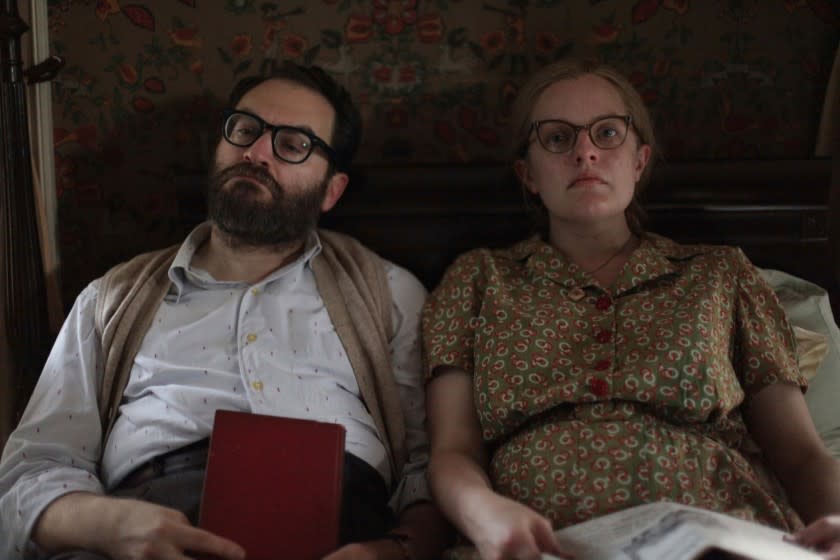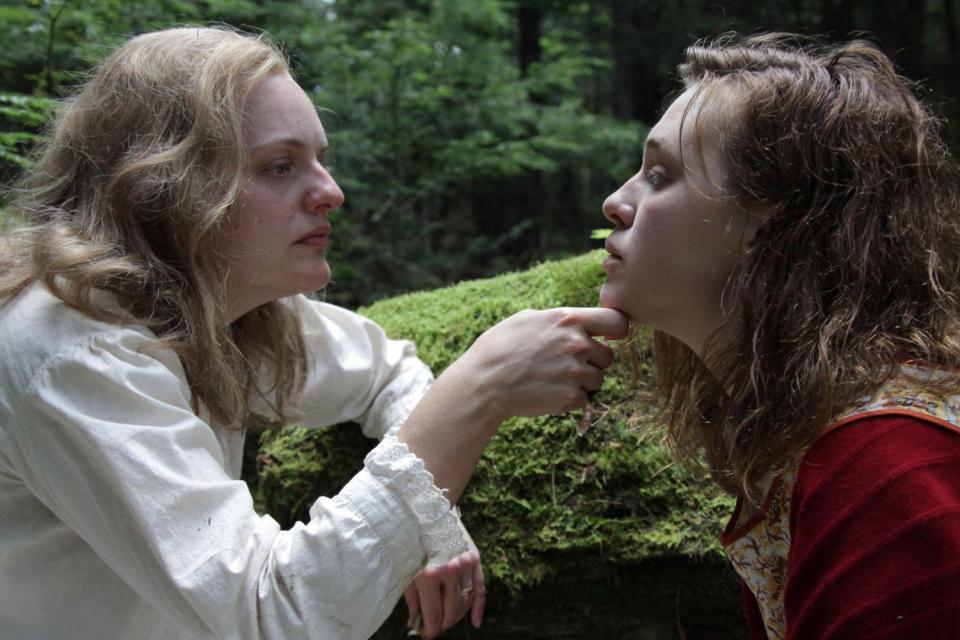Review: 'Shirley,' with Elisabeth Moss as Shirley Jackson, is a cunning psychological brew

Home is where the horror is in the gothic fiction of Shirley Jackson, though seldom in ways you might expect. Think of “The Haunting of Hill House,” in which a spooky manor merges inextricably with the twisted architecture of a young woman’s mind. Or think of “We Have Always Lived in the Castle,” where an isolated chateau full of grim family secrets becomes, for its 18-year-old protagonist, a place of unlikely refuge from the even graver threat of the outside world.
The peculiar brilliance of Jackson’s writing — the sly interplay of wit and horror, pleasure and revulsion in those precisely chiseled sentences — itself grew out of an all-too-real foundation. By various biographical and scholarly accounts, the Vermont home she shared with her husband, literary critic and professor Stanley Edgar Hyman, had the effect of both constraining and nurturing her gift. The drudgery of cooking, cleaning and raising four children became an obstacle as well as a source of inspiration. (Jackson conceived her classic 1948 short story “The Lottery” while pushing her daughter uphill in a stroller full of groceries; she wrote it in less than two hours that same day.)
And so it seems entirely apt to treat “Shirley” — Josephine Decker’s beautiful, boldly untethered new film about Jackson’s life and work — as a kind of negotiation between at least two housebound genres. Decker’s feverish technique evokes the grammar of the old-fashioned ghost story: a camera that swerves and swoops, a score that thrums with menace, an old manse full of dark shadows, creaky floorboards and disorienting mirrors. (Her fine collaborators include cinematographer Sturla Brandth Grøvlen, composer Tamar-kali and production designer Sue Chan.) But the overall tone veers away from horror and into a rich vein of dark humor, spinning the everyday torments of Jackson’s life — a flagrantly unfaithful husband, harrowing bouts of depression and anxiety — into a furious comedy of marital discord.
However you classify this movie — and the only category that doesn’t fit, really, is “literary biopic” — there can be no denying that Shirley herself, played with unsurprising bravura by Elisabeth Moss, is its swirling, mercurial center. This is true even though “Shirley,” loosely adapted from Susan Scarf Merrell’s novel of the same title, initially locates its perspective with another character altogether. We first meet Shirley and Stanley (Michael Stuhlbarg) through the eyes of Rose Nemser (Odessa Young), the bright, personable young wife of Stanley’s new teaching assistant, Fred (Logan Lerman), at nearby Bennington College.
Rose and Fred become long-term guests in Shirley and Stanley’s wildly overgrown red-brick house, and for reasons that go beyond mere hospitality. Although she is first seen acerbically holding court at one of Stanley’s parties, Shirley turns out to be the opposite of a social creature. When Rose professes her love for “The Lottery,” the author can barely muster enough energy for an eye-roll. She hasn’t left home in ages; her writing has slowed to a halt. And Stanley, a gregarious manipulator, all but pushes Rose into the unenviable role of Shirley’s caretaker and companion, the better to pursue his work and his extramarital affairs in peace.
But while Shirley may have difficulty crawling out of bed, she turns out to be nobody’s pushover. Moss, showing no loss of emotional acuity or stamina after the dramatic exertions of “Her Smell” and “The Invisible Man,” turns this sneering, sallow-haired woman into her latest tour de force, a misanthrope with a bespectacled glare nearly as sharp as her tongue. And Stuhlbarg — who, between this and “Call Me by Your Name,” was clearly born to play middle-age bohemian academics — nearly matches Moss jab for venomous jab. Their verbal spats, leavened by odd flashes of tenderness and resignation, send this dramatic quadrangle careening into “Who’s Afraid of Virginia Woolf?” territory, leaving Fred and Rose to stammer timidly on the sidelines as the story’s designated Nick and Honey.

But Rose soon emerges from her initial shock, and Young’s arresting mix of cool poise and warm feeling anchors the movie even as it pushes it in a surprising narrative direction. Although she and Fred are as frisky as you’d expect from two attractive young newlyweds, Rose can see in her marriage a future echo of Shirley and Stanley’s unhappiness, especially when Fred starts mimicking Stanley’s academic ambition and his chronic infidelity. Surrounded by so many useless, faithless men, Rose discovers in Shirley a prickly kindred spirit as well as a conduit for rebellion — an emotional bond in which creative inspiration and erotic desire freely commingle.
Merrell’s novel was already a heavily fictionalized treatment of Jackson’s life, and Sarah Gubbins' script fittingly takes a pickax to its own source material. Crucial biographical details have been blurred or excised; Stanley and Shirley’s four children are neither seen nor mentioned. While the book was set in fall 1964, a year before Jackson’s death from heart failure, the movie has been moved closer to 1951, the year that her second novel, “Hangsaman,” was published. We see Shirley writing that book and drawing inspiration from the real-life case of Paula Jean Welden, a Bennington student who mysteriously disappeared in 1946. Welden haunts, disturbs and influences Shirley’s visions; so does Rose, who becomes a gauzy stand-in for that missing student.
If all these slippery layers of reality and artifice sound a little confusing, that’s very much by design. Decker previously directed “Madeline’s Madeline” (2018), an intoxicating meta-jumble about the relationship between a gifted, troubled young actress and her manipulative theater director. The more linearly structured “Shirley” may look conventional on the surface, though its playful, inquisitive sensibility is borderline radical compared with most of the biographical fictions that Hollywood pumps out. Decker’s raw, jagged aesthetics are very much in evidence. So are her signature fascinations: the ever-blurry line separating art from life, the creative properties of mental illness and the ecstasies of artistic creation, especially art by and about women.
To some extent, “Shirley” delights in its own dissembling, but it also uses these complications to arrive at a place of startling truth. The sorcery in which Jackson claimed to dabble in real life finds a cinematic corollary in the movie’s bewitching late passages, which are by turns disorienting and illuminating. When the smoke abruptly clears, we’re left with a newfound appreciation of that ramshackle old house, and also of a great writer not yet past the peak of her powers, but approaching it. Home is where the art is.

